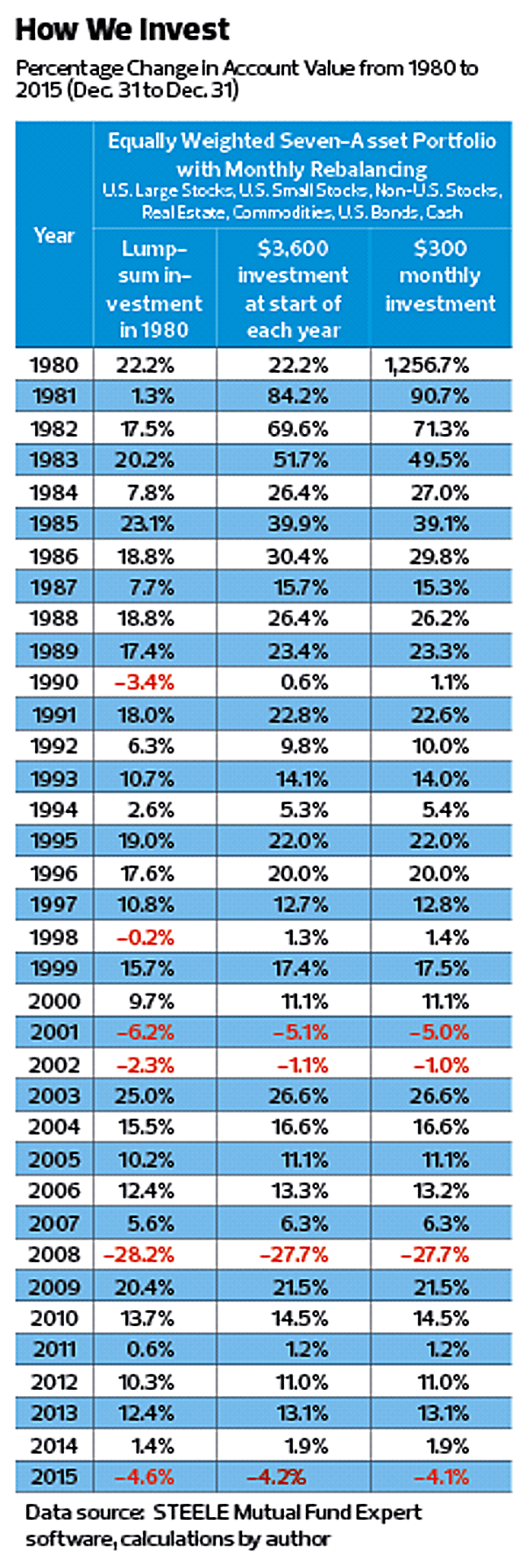 Here’s another post on the topic of creating good habits…
Here’s another post on the topic of creating good habits…
A common investing question is whether it is better to invest your money all at once (lump-sum) or gradually over time (dollar-cost averaging). The standard answer is that lump-sum is generally a better choice than dollar-cost averaging. This is mostly simple mathematics; If something goes up on average, then you’ll want your money in as early as possible.
However, in this Financial Planning magazine article Does investing monthly or annually beat a lump-sum portfolio? by Craig L. Israelsen, he argues that in the real world the best solution is regular, monthly investing. I recommend reading the original piece, but here is how I mentally broke down the concept:
- The most important thing to building wealth is saving a lot of money (savings rate).
- The best way to save a lot is to save often over time.
- The best way to save often is to develop a regular habit of it, so that it becomes effortless over the years.
- The hardest part about developing a habit is at the very beginning. You need an initial streak that is uninterrupted.
- The most likely thing to interrupt your streak is seeing a big drop when you look at your monthly account statements. That is scary. As humans, we like to focus on that number.
- With lump-sum contributions, you are much more likely to see a drop on a month-to-month basis. You have committed your money, and it is now subject to the market’s whims. You are also given a lot of time to think between actions, and you’ll have to muster up the motivation to make another lump-sum investment later.
- With regular, monthly contributions and a small portfolio size, you will hardly ever see an account balance drop.
Historical data from 1980-2015. Consider a diversified portfolio of stocks and bonds (details in the article). The following chart has three columns that compare overall market returns, an annual investment of $3,600 made each year on January 1st, and a monthly investment of $300 made at the start of each month.

In the beginning, your account balance “feels” like it is always growing, even though the market itself may be flat or even dropping. This is the benefit of regular, monthly contributions. The positive reinforcement will hopefully let an investing habit form. As your portfolio gets bigger, the difference between dollar-cost averaging and lump-sum investing becomes relatively insignificant.
Bottom line. Building the habit is the most important thing. If at all possible, you should make automatic, monthly investments. When your account is small, systematic investments make it more likely that the number on your monthly statement keeps rising every month. By the time that your portfolio starts to get big enough that it doesn’t help anymore, you’ll have already built the habit and be on the path to solid wealth. By the way, if you invest as soon as you have the money available (i.e. when you get your paycheck) then you already are getting your money in the market as soon as possible.
 The Best Credit Card Bonus Offers – 2025
The Best Credit Card Bonus Offers – 2025 Big List of Free Stocks from Brokerage Apps
Big List of Free Stocks from Brokerage Apps Best Interest Rates on Cash - 2025
Best Interest Rates on Cash - 2025 Free Credit Scores x 3 + Free Credit Monitoring
Free Credit Scores x 3 + Free Credit Monitoring Best No Fee 0% APR Balance Transfer Offers
Best No Fee 0% APR Balance Transfer Offers Little-Known Cellular Data Plans That Can Save Big Money
Little-Known Cellular Data Plans That Can Save Big Money How To Haggle Your Cable or Direct TV Bill
How To Haggle Your Cable or Direct TV Bill Big List of Free Consumer Data Reports (Credit, Rent, Work)
Big List of Free Consumer Data Reports (Credit, Rent, Work)
Can you clarify what the numbers in that table represent? I’m very skeptical that is, say, the internal rate of return (or even overall return).
As noted at the top of the chart, the numbers are percentage change in account value, not IRR. It tries to measure what a person would “see” on their monthly account statements. I would really just compare the rightmost 2 columns.
Yea, these numbers dont add up. First, it does not make sense that they do “monthly rebalancing”. NO data supports that as a preferred investment approach. Does the data account for the taxes on that? Second, this data would imply that buy and hold is sub-optimal. Pass that by Vanguard/boogleheads. Thirdly, who would recommend 1/7th of assets in commodities?
It would be more interesting to see this data with a more realistic set of assumptions, or at least the monthly rebalancing removed. I’ll have to review that article to try to make more sense of this.
I really doubt the monthly rebalancing changes the numbers in any significant way as to affect the point of the article – to differentiate between a new investor putting $3,600 all at once in the beginning of the year, and then compare that with putting in $300 every a month. I agree that the argument is not put forward in the clearest possible way, which is why I tried to rephrase it in this post.
Israelsen developed the 7Twelve portfolio. You can see his reasoning here http://www.7twelveportfolio.com
I’m with you! I’ve been doing automated monthly saving for 31 years, and can attest to the fact that consistent investing, done over a long period of time, is the best path to wealth. Good article.
The columns are comparing apple and orange. One can tell immediately that the article was written by the so-called “financial planner”, who catered to regular Joe savers, who can only contribute regular small amount($300/m), and to demonstrate to “financial planner” the logic in how to “lock-up” their clients.
Imagine that you have a lump sum of $1M in 1979, it would be foolish to split that capital into $1M/36=28k/y. I am not saying that regular monthly saving is bad.